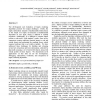Free Online Productivity Tools
i2Speak
i2Symbol
i2OCR
iTex2Img
iWeb2Print
iWeb2Shot
i2Type
iPdf2Split
iPdf2Merge
i2Bopomofo
i2Arabic
i2Style
i2Image
i2PDF
iLatex2Rtf
Sci2ools
HAPTICS
2006
IEEE
2006
IEEE
Standardized Evaluation of Haptic Rendering Systems
The development and evaluation of haptic rendering algorithms presents two unique challenges. Firstly, the haptic information channel is fundamentally bidirectional, so the output of a haptic environment is fundamentally dependent on user input, which is difficult to reliably reproduce. Additionally, it is difficult to compare haptic results to real-world, “gold standard” results, since such a comparison requires applying identical inputs to real and virtual objects and measuring the resulting forces, which requires hardware that is not widely available. We have addressed these challenges by building and releasing several sets of position and force information, collected by physically scanning a set of real-world objects, along with virtual models of those objects. We demonstrate novel applications of this data set for the development, debugging, optimization, evaluation, and comparison of haptic rendering algorithms. CR Categories: H.5.2 [User Interfaces]: Haptic I/O
Haptic Environment | Haptic Information Channel | Haptic Rendering Algorithms | HAPTICS 2006 | Virtual Reality |
| Added | 11 Jun 2010 |
| Updated | 11 Jun 2010 |
| Type | Conference |
| Year | 2006 |
| Where | HAPTICS |
| Authors | Emanuele Ruffaldi, Dan Morris, Timothy Edmunds, Federico Barbagli, Dinesh K. Pai |
Comments (0)

